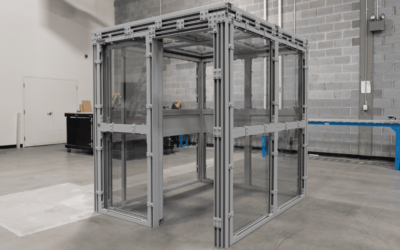For the last 20 years, TotalShield has been leading the shielding enclosure industry. This new blog series will explore case studies about unique solutions we’ve designed, tested, and manufactured for our customers.
Our first case study will focus on the design of a lithium-ion battery container and a battery testing chamber.
Our Customer’s Request
An international manufacturing company approached us with a request to design an enclosure to test lithium-ion batteries safely. Our customer required:
- A robust solution to ensure their staff’s safety in the case of battery fire or explosion
- A complete testing and verification report backed by third-party empirical testing
While the company had many world-class in-house engineers, they were unsure how to design the containment solution due to the multiple modes of failure associated with lithium-ion batteries. That is why they turned to TotalShield, and we leveraged our 20 years of experience in ballistic and blast enclosure design to engineer the perfect shielding solution.
Common Failures of Lithium-ion Batteries
Lithium-ion batteries are widely used for electrical applications that require high-energy density, such as consumer electronic devices, grid storage, and electric vehicles. In a quest to increase the capacity of lithium-ion batteries, manufacturers have incorporated multiple batteries into battery packs, where multiple lithium-ion cells are aggregated into a single unit along with charging hardware and protective circuits.
High-capacity battery packs must be carefully designed and tested to prevent failure. Several high-profile failures have occurred in the recent past. For example, in 2006, an industrial laptop battery manufacturer began to encounter catastrophic failures in its product, which supplied many of the top laptop manufacturers. These failures included overheating, fire, and explosions. The resulting recall affected millions of laptops that had to be repaired and/or replaced.
One of the most catastrophic failures of a lithium-ion battery system is a cascading thermal runaway event where multiple cells in a battery fail due to a failure starting at one individual cell. Thermal runaway can occur due to exposure to excessive temperatures, external shorts due to faulty wiring, or internal shorts due to cell defects.
According to the International Association of Engineering Insurers (IMIA):
“Thermal runaway events result in the venting of toxic and highly flammable gasses and the release of significant energy in the form of heat. If ignited, these gases can cause enclosed areas to overpressurize, and if unmitigated, this overpressure can result in an explosion and severe damage to the battery and surrounding equipment or people.”
Designing Primary and Secondary Lithium-ion Battery Testing Enclosures
The customer provided TotalShield with battery pack samples to be used to quantify the ballistic, explosive, and fire threats associated with thermal runaway events triggered by overcharging.
Because this had never been quantified previously, we partnered with Southwest Research Institute to perform independent tests in which the batteries overcharging circuitry was purposely disabled. This allowed the batteries to be intentionally brought to failure using excessive charge. Our partner then measured the temperatures, pressures, and ballistic ejections associated with the failures and passed this extensive test data to TotalShield.
We then designed a primary containment system based on the test data and a margin of safety. The system is a cabinet enclosure mounted on a mobile cart, designed to contain the explosive and ballistic failure of the battery pack while also allowing the venting of gases safely. Because the customer wanted to observe and film the battery tests, this lithium-ion battery container enclosure includes clear polycarbonate panels on all four sides, as shown in the design drawing below.
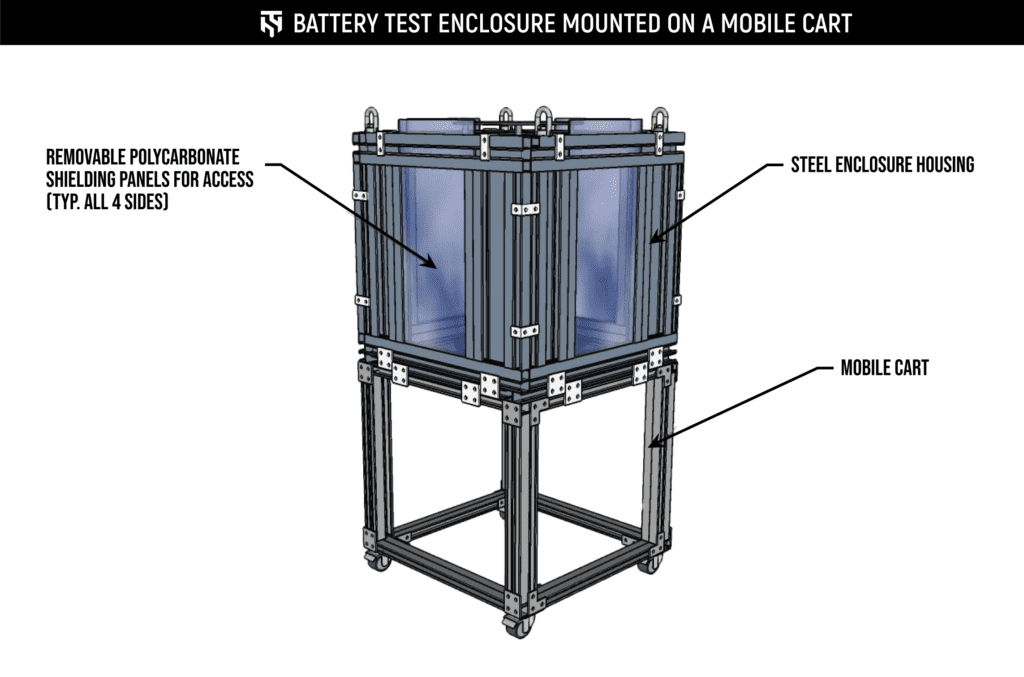
Due to the high heat associated with a lithium-ion battery that catches on fire, we designed a thermally isolated steel test table that minimizes the amount of heat transmitted to the rest of the enclosure and to the outside environment.
Similarly, we designed a thermally isolated flame and heat shield for the top of the enclosure, below a vent to release combustion gases. Since the polycarbonate panels can be marred or disfigured during testing, we also designed all four polycarbonate panels to be easily replaceable.

Our customer was unsure of which battery sizes and types might be tested in the future, so we also designed and built a lithium battery test chamber with polycarbonate panels to act as secondary containment. See the figure below.
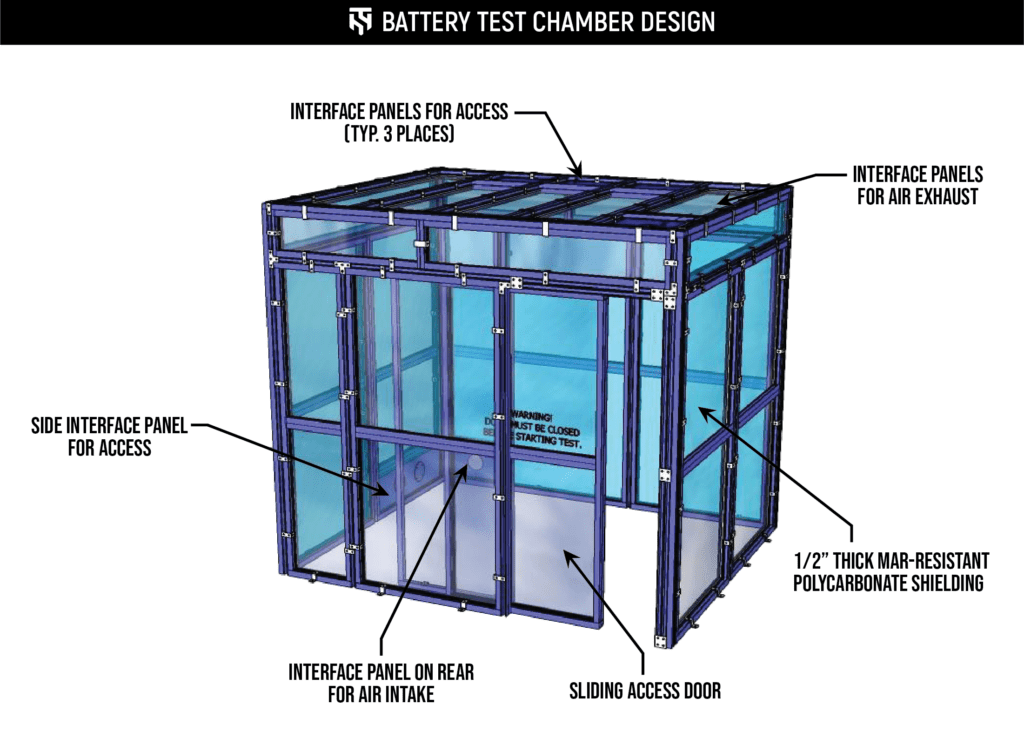
The primary lithium-ion battery testing enclosure inside the secondary test chamber looks like the following:
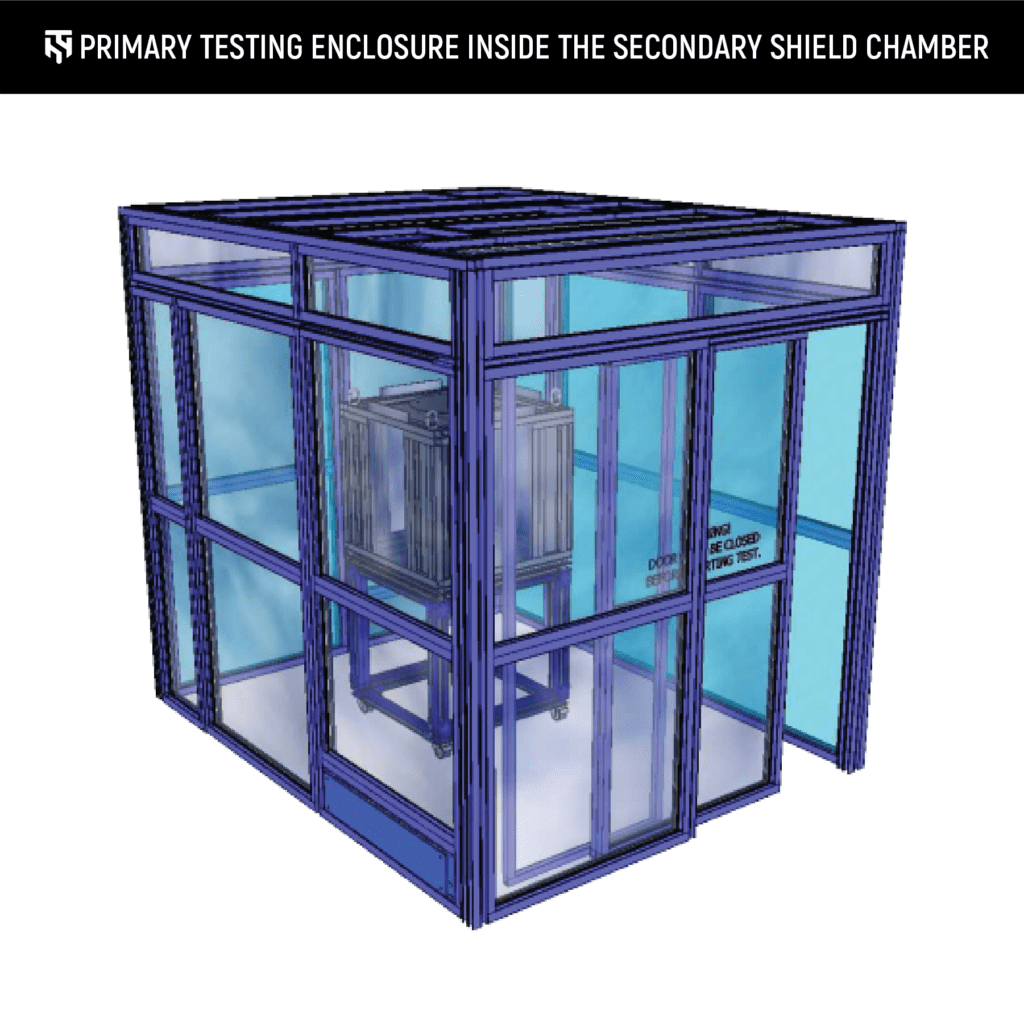
Battery Testing Process in a Polycarbonate Enclosure
The battery testing process consists of the following steps:
- Open the Primary Containment Enclosure by removing one or more of the polycarbonate panels.
- Unit Under Test (UUT) is placed with the Primary Containment Enclosure, on the test table, and wired up.
- Replace all polycarbonate panels that were removed.
- The Primary Containment Enclosure is then placed within the Secondary Containment Shield Room.
- Cameras are then set up to be operated from outside the Secondary Containment Shield Room.
- Personnel should exit the Secondary Containment Shield Room, door is closed, and exhaust system activated.
- Testing commences.
- Post-test, personnel should remain outside the Secondary Containment Shield Room until adequately vented (depends on the flow rate of the fans).
- Personnel can safely enter the Secondary Containment Room and examine the UUT.
The final product as manufactured is shown in the photo below.
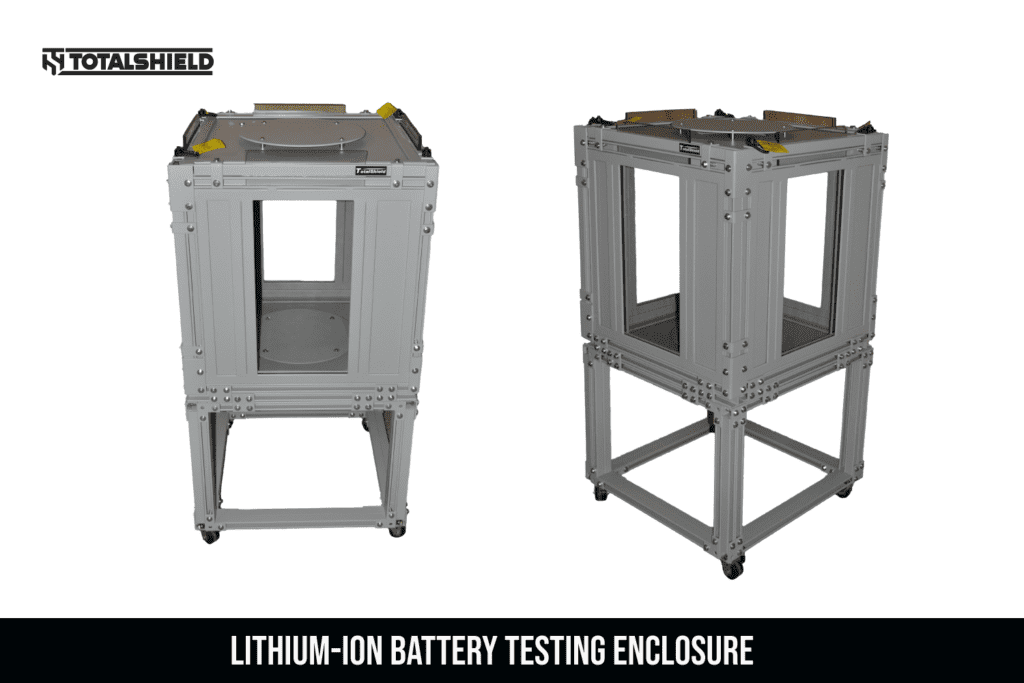
This project is an excellent example of our collaborative approach, in which we work with our customers to:
- Evaluate a threat associated with a customer process or test,
- Quantify the threat in conjunction with a third-party testing partner using real-world tests to ensure we understand the magnitude of the threat, and
- Design and manufacture a safety enclosure to mitigate the threat and keep personnel safe.
If you have potentially a hazardous test process involving high heat, pressure, or ballistic failure please contact us and we will work with you to develop the perfect safety enclosure.



